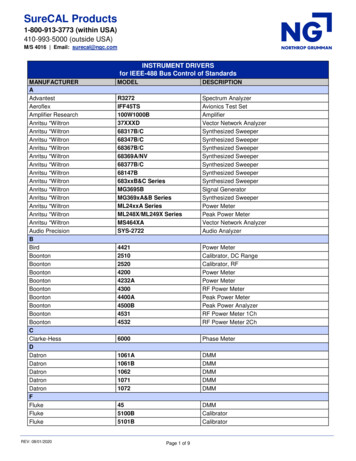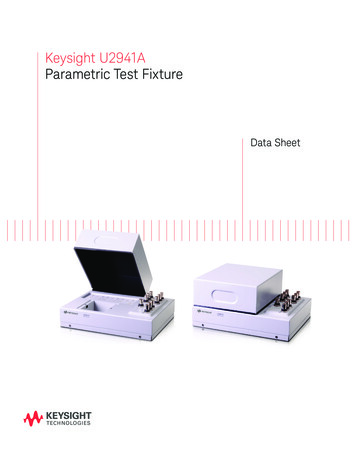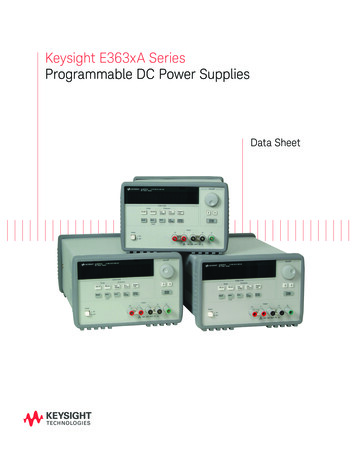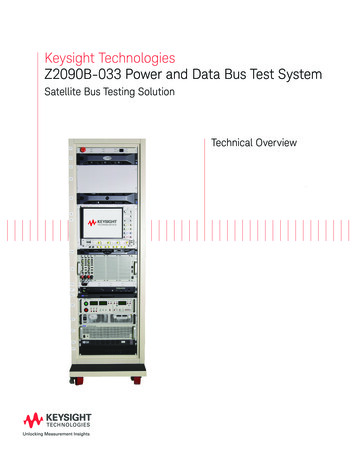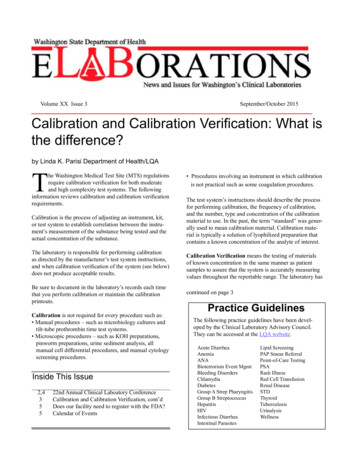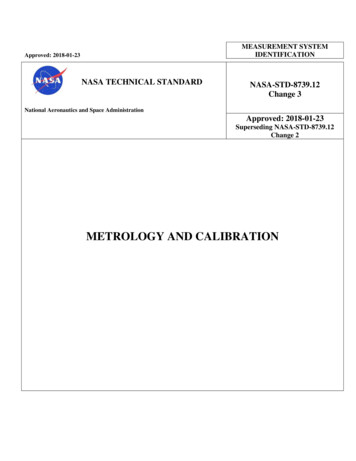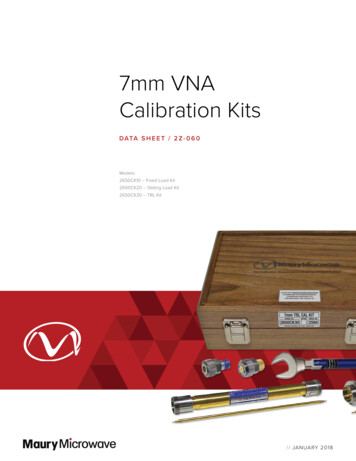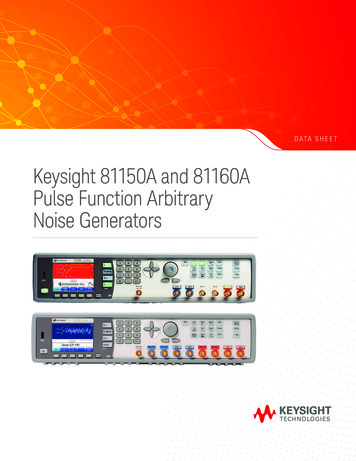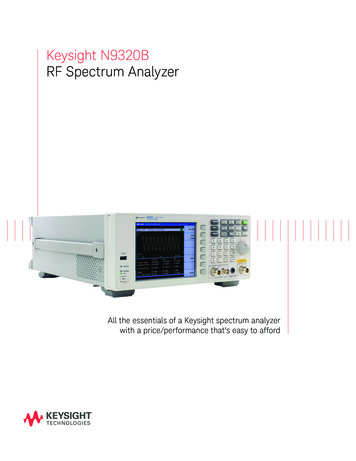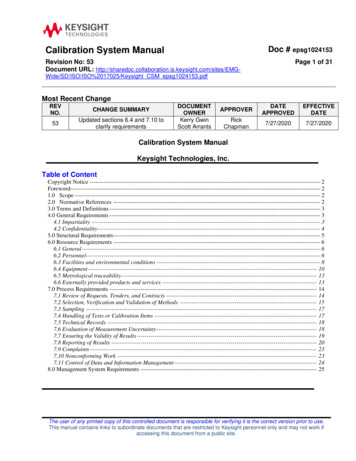
Transcription
Doc # epsg1024153Calibration System ManualRevision No: 53Document URL: s/EMG-Page 1 of 31Wide/SD/ISO/ISO%2017025/Keysight CSM epsg1024153.pdfMost Recent ChangeREVNO.CHANGE SUMMARY53Updated sections 6.4 and 7.10 toclarify requirementsDOCUMENTOWNERKerry GwinScott n7/27/20207/27/2020Calibration System ManualKeysight Technologies, Inc.Table of ContentCopyright Notice ------------------ ------------------------------------- 21.0 Scope -------------------------- 22.0 Normative References ------ 23.0 Terms and Definitions -------- 34.0 General Requirements -------- 34.1 Impartiality ----------------- 34.2 Confidentiality -------------- 45.0 Structural Requirements ------ 56.0 Resource Requirements ------ 66.1 General ---------------------- 66.2 ----------------------------- 66.3 Facilities and environmental conditions ---------------------------------- 86.4 Equipment ----------------- 106.5 Metrological traceability -------------------------------------------------- 136.6 Externally provided products and services ----------------------------- 137.0 Process Requirements ------ 147.1 Review of Requests, Tenders, and Contracts --------------------------- 147.2 Selection, Verification and Validation of Methods -------------------- 157.3 Sampling ------------------ 177.4 Handling of Tests or Calibration Items --------------------------------- 177.5 Technical Records ------- 187.6 Evaluation of Measurement Uncertainty -------------------------------- 187.7 Ensuring the Validity of Results ------------------------------------------ 197.8 Reporting of Results ----- 207.9 Complaints ---------------- 237.10 Nonconforming Work -- 237.11 Control of Data and Information Management ----------------------- 248.0 Management System Requirements ---------------------------------------- 25The user of any printed copy of this controlled document is responsible for verifying it is the correct version prior to use.This manual contains links to subordinate documents that are restricted to Keysight personnel only and may not work ifaccessing this document from a public site.
Calibration System ManualDoc # epsg1024153Revision No: 53Document URL: s/EMG-Page 2 of 31Wide/SD/ISO/ISO%2017025/Keysight CSM epsg1024153.pdfCopyright Notice Copyright 2002-2017 Keysight Technologies, Inc. All rights reserved. Reproduction,adaptation, or translation without prior written permission is prohibited, except as allowedunder copyright laws.ForewordThis calibration system manual has been written for all organizations within KeysightTechnologies, Inc.Responsibility for the document contents belong to the Keysight Technologies BusinessManagement System Manager.1.0 ScopeThis document is used by all facilities providing calibration services that include, but arenot limited to: Calibration Facilities Entities that provide calibrations at customer or remote locations Manufacturing Test and Calibration FacilitiesOrganizational processes and procedures will be required to supplement, but notsupersede, the Calibration System Manual.2.0 Normative ReferencesThis document describes procedures employed by Keysight Technologies’ CalibrationFacilities for the calibration of instruments. The paragraph numbering used in thisdocument is consistent with that used in ISO/IEC 17025:2017. Included in the scope ofthe document are: Calibration facilities’ policies, procedures, and processes established to meet therequirements of ISO/IEC 17025:2017, ANSI/NCSL Z540.1-1994 (R2002),ANSI/NCSL Z540.3-2006, ISO 10012:2003 and the needs of customers and/orexternal registration bodies.The user of any printed copy of this controlled document is responsible for verifying it is the correct version prior to use.This manual contains links to subordinate documents that are restricted to Keysight personnel only and may not work ifaccessing this document from a public site.
Calibration System ManualRevision No: 53Document URL: s/EMG-Doc # epsg1024153Page 3 of 31Wide/SD/ISO/ISO%2017025/Keysight CSM epsg1024153.pdf Provides a detailed description of how calibration is accomplished at KeysightTechnologies.3.0 Terms and DefinitionsThis document uses the definitions of the International Vocabulary of Metrology (JCGM200:2012), ISO/IEC 17025:2017, ANSI/NCSL Z540.1-1994 (R2002) and ANSI/NCSLZ540.3-2006, as well as other terms applied to calibration activities described below.Instruments Measuring and Test Equipment (M&TE) – This comprises all of the measuringinstruments, measurement standards, reference materials, and auxiliary apparatusthat are necessary to perform a measurement. This term includes measuringequipment used in the course of testing and inspection, as well as, that used incalibration. Measurement Standard – A material measure, measuring instrument, referencematerial or system intended to define, realize, conserve or reproduce a unit or one ormore known values of a quantity to serve as a reference. Items used for measuringstandards generally fall into one of the several categories defined in the StandardType Definition document.OrganizationKeysight calibration facilities have varying reporting structures in the corporation forexample they may be grouped into regional service organizations, manufturingorganizations, etc. Within this document the term organizations may be used torepresent any of these levels or groupings of calibration facilities.4.0 General Requirements4.1 Impartiality4.1.1 Keysight ensures impartiality through organizational structure and alignment andthrough strategic, customer, operational, and quality driven objectives and goals.The user of any printed copy of this controlled document is responsible for verifying it is the correct version prior to use.This manual contains links to subordinate documents that are restricted to Keysight personnel only and may not work ifaccessing this document from a public site.
Calibration System ManualRevision No: 53Document URL: s/EMG-Doc # epsg1024153Page 4 of 31Wide/SD/ISO/ISO%2017025/Keysight CSM epsg1024153.pdf4.1.2 Keysight management ensures impartiality by focusing on the needs andrequirements of customers. This is achieved via operational and quality driven reviews andreinforced through mandated training such as Standards of Business Conduct.4.1.3 As per Keysight Technologies Standards of Business Conduct, Keysight discouragesmonetary or other compensation that would constitute a conflict of interest and affect thetechnical judgment of individuals involved in the calibration of measurement and testequipment.4.1.4 Every effort is made to ensure that employees working within a calibration facilityenvironment are not directly subjected to work related pressures that could compromise thequality of their work and impartiality. Keysight Technologies Standards of Business Conductaddresses employee integrity, ethics, and conflicts of interest. Keysight employees arerequired to review these standards annually.Employees are trained to utilize specific processes to accomplish their tasks and have a clearunderstanding of what must be done to realize technically valid results. Those processeshave been designed with quality measures in place to ensure conformity of the deliverables.4.1.5 If a risk to impartiality is identified it will be addressed in accordance with the KeysightTechnologies Standards of Business Conduct.4.2 Confidentiality4.2.1 Customer confidential information, proprietary rights, results of calibrations and anyspecial requests regarding customer calibrations are treated as confidential.4.2.2 If Keysight Technologies is required by law or authorized by contractual arrangementsto release confidential information, the associated customer/s will be informed.4.2.3 Any information obtained from third-parties related to specific customer/s, will betreated as confidential between the customer/s and Keysight. Any third-patry information willonly shared with the customer/s if the source of the information provides agreement to do so.4.2.4 Employees are required to review Keysight Technologies Standards of BusinessConduct annually. The related requirements for Keysight Suppliers can be found onwww.keysight.com in the supplier portion of the quality page.The user of any printed copy of this controlled document is responsible for verifying it is the correct version prior to use.This manual contains links to subordinate documents that are restricted to Keysight personnel only and may not work ifaccessing this document from a public site.
Calibration System ManualDoc # epsg1024153Revision No: 53Document URL: s/EMG-Page 5 of 31Wide/SD/ISO/ISO%2017025/Keysight CSM epsg1024153.pdf5.0 Structural Requirements5.1All calibration facilities within Keysight Technologies are part of the legal entityKeysight Technologies, Inc. and legally defined in the various countries of operation.5.2The calibration facilities’ managers are identified as per associated organization chartsand have the necessary authorityto ensure that planning, resourcing, directing and controllingof the operation are provided to meet customer, quality, and business objectives.5.3Calibration facilities that are accredited to ISO/IEC 17025:2017 maintain a Scope ofAccreditation with their respective accreditation body.5.4Keysight Technologies Calibration Facilities carry out activities in a way that meet therequirements of ISO/IEC 17025:2017, ANSI/NCSL Z540.1-1994 (R2002), ANSI/NCSLZ540.3-2006, and ISO 10012:2003 as applicable based on customer and contractualrequirements. This applies to activities performed at all permanent facilities, at sites awayfrom permanent facilities, in associated temporary or mobile facilities or at customer facilities.5.5Keysight Technologies Calibration Facilities maintain the following:a) A management structure is depicted in the calibration facilities’ organizational charts.These charts demonstrate the interaction of all parts of the calibration facilities and therelationship with the corporate structure.b) Organizational charts, detailed job descriptions, various process flow charts andwritten procedures, indicate the responsibility, authority and connectivity of everyonedirectly involved in performing calibration activities within the calibration facilities.c) Orginaztional documentation is maintained to ensure the consistent application ofcalibration facility activities and the validity of laboratory obtained results.5.6Calibration activities are supervised by personnel who have extensive experience andwho are often assisted by team or group leaders as necessary to ensure the quality of thecalibrations being performed. The calibration facilities staff understand the objective ofThe user of any printed copy of this controlled document is responsible for verifying it is the correct version prior to use.This manual contains links to subordinate documents that are restricted to Keysight personnel only and may not work ifaccessing this document from a public site.
Calibration System ManualRevision No: 53Document URL: s/EMG-Doc # epsg1024153Page 6 of 31Wide/SD/ISO/ISO%2017025/Keysight CSM epsg1024153.pdfcalibration and how to assess the vailidity of the results obtained. Organizationaldocumentation, such as training records, are utilized to satisfy this requirement.Each calibration facility has access to at least one person who is technically expert incalibration and metrology. This person may be a metrologist, technical supervisor, technicalspecialist, engineering support/management or the metrology manager who has theresponsibility to make decisions regarding the technical validity of all aspects of thecalibration process.Each calibration facility is supported by a quality representative who is responsible forcoordinating all quality functions including auditing, vendor assessments, trainingrecommendations, assessment of the effectiveness of the Business Management Systemand the assistance of employees with the concepts and tools necessary for use within qualityimprovement projects and initiatives.All calibration personnel have the authority to identify deviations from the managementsystem or procedures and are able to initiate actions to prevent such deviations. This ismonitored by the quality representative and facility management.5.7All Keysight Calibration Facilitiesa) communicate the effectiveness of the management system and importance of meetingcustomer and other requirements through the use of newsletters, coffee talks, meetingsand other appropriate means andb) maintain the integrity of the management system when changes are implemented.6.0 Resource Requirements6.1 GeneralKeysight facilities have the personnel, equipment, systems and support services to performall their required calibration activities.6.2 Personnel6.2.1 All personnel are trained in accordance with the Keysight Training ProcessRequirements.The user of any printed copy of this controlled document is responsible for verifying it is the correct version prior to use.This manual contains links to subordinate documents that are restricted to Keysight personnel only and may not work ifaccessing this document from a public site.
Calibration System ManualRevision No: 53Document URL: s/EMG-Doc # epsg1024153Page 7 of 31Wide/SD/ISO/ISO%2017025/Keysight CSM epsg1024153.pdfThe calibration facilities have staff of sufficient size and knowledge to satisfy the capacityand technical capability needed to support their workload. Personnel are hired to fulfillspecific job requirements. Formal training may be required as a method of providingemployee technical education. On-the-job training (OJT) is utilized when appropriate andgives employees the opportunity to experience new situations or service a broader productrange by learning in a controlled environment where assistance is readily available throughmentoring. Implementation of OJT is per management discretion and continues until amentor is satisfied that the required level of competence has been attained.Acquired experience is also valuable in supporting specific products and, if substantiated,can be a training qualifier for those products. Qualification criteria includes, but is not limitedto, the following aspects: Supervisor knowledge and assessment during qualification, Support of a minimum number of products to qualify, Previous support of similar products or product lines6.2.2 Training and education goals for the calibration facilities personnel are reviewed eachyear as part of the employee job performance. Available training may include formal trainingclasses, attendance of metrology conferences, etc. Training records are maintained for eachmember of the calibration facilities.6.2.3 Under the direction of the manager of the calibration facility, the technicians candevelop technical areas of specialization. The calibration facilities technicians areresponsible for creating and continuously improving processes, procedures, and software inthe assigned area(s) of responsibility. These activities form much of the basis for techniciantechnical training. The technician with primary responsibility for an area also oversees anyday-to-day cross training of other technicians in that technical area.6.2.4 Job descriptions are located on the Job Family Matrices website within the HRapplication.6.2.5 Procedures and records associated with determining competence, selection andtraining of personnel, supervision and authorization of personal and monitoring ofcompetence can be found in SuccessFactors or other locally maintained record keepingsystems.6.2.6 Keysight management identifies and authorizes the appropriate individuals to:The user of any printed copy of this controlled document is responsible for verifying it is the correct version prior to use.This manual contains links to subordinate documents that are restricted to Keysight personnel only and may not work ifaccessing this document from a public site.
Doc # epsg1024153Calibration System ManualRevision No: 53Document URL: s/EMG-Page 8 of 31Wide/SD/ISO/ISO%2017025/Keysight CSM epsg1024153.pdfa) develop, modify, verify and validate calibration methods;b) analyse results, including statements of conformity or opinions andinterpretations;c) report, review and authorize results.Individuals performing calibrations are authorized to perform calibrations (or repairs), issuecalibration certificates or reports, and operate particular types of equipment. Thisauthorization is documented in training or competency records and shall include the dateupon which the scope and level of competence was obtained. Historical records shall be keptas evidence of qualification to perform the stated activity at the time of its provision.Temporary and/or contract technicians or other personnel are subject to the samerequirements as permanent employees depending on work responsibilities. These personnelwork under the direct supervision of a mentor until appropriately trained.6.3 Facilities and environmental conditions6.3.1 In the design of the calibration environment, consideration has been given to theoperating specifications of the required M&TE and the operating specifications of the unitunder test. The facilities are air-conditioned and consideration has been given to cleanliness,temperature and humidity. Where necessary, the facility power line supply is regulated withproper line conditioning to ensure proper operation of the measurement and test equipment.Consideration will be given to the environmental requirements of the most sensitivemeasurement performed. Environmental conditions are reported as a range of acceptablevalues.6.3.2 Typical environmental requirements for facilities are as follows:Type of FacilityTemperature RangeHumidity RangeDefault Calibration Facility23 5 C20 to 80% RHRF or DC/Low Frequency 23 1 CStandards Facilities30 to 55% RHThe user of any printed copy of this controlled document is responsible for verifying it is the correct version prior to use.This manual contains links to subordinate documents that are restricted to Keysight personnel only and may not work ifaccessing this document from a public site.
Doc # epsg1024153Calibration System ManualRevision No: 53Document URL: s/EMG-Page 9 of 31Wide/SD/ISO/ISO%2017025/Keysight CSM epsg1024153.pdfPhysical/DimensionalFacilities20 1 C20 to 60% RHSome facilities may require tighter limits that will be dictated by the type of calibrations beingperformed and/or the equipment being used. Should a facility require wider limits a waiverusing either the standard waiver process or a documented waiver process approved by theorganization’s Metrology shall be in place. Some facilities, such as Hardware Test Centers(HTC), comply with alternate international standards (such as IEC 61010-1 4.3.1) forenvironmental limits.6.3.3 Each calibration facility is equipped with an environmental monitoring system.Records are maintained and stored per Keysight Quality Records Requirements.If at any time the environmental limits are not met, the calibration operation shall besuspended until that condition has been investigated and addressed.6.3.4 Activities are effectively separated when the failure to do so could compromise theintegrity of the calibrations being performed. Measures shall be taken to prevent crosscontamination.Access to the calibration facilities are controlled. ESD precautions as defined in KeysightTechnologies’ ESD Control Manual are taken when handling M&TE and units under test.Each member of the calibration facilities are responsible for general housekeeping and forcomplying with all Health & Safety regulations. Common areas and building systems, suchas air conditioning, are maintained by a workplace solutions group or contract personnel whoshall meet Keysight security and access requirements.6.3.5 When calibrations are performed at a customer's site, Keysight monitors and recordsthe environmental conditions. Keysight requires a typical set of conditions in which to performthe calibrations. If the customer is unable to provide an area that meets these conditions,Keysight Technologies requires a standard waiver by both the customer and KeysightMetrology to complete the calibration activities as needed.The user of any printed copy of this controlled document is responsible for verifying it is the correct version prior to use.This manual contains links to subordinate documents that are restricted to Keysight personnel only and may not work ifaccessing this document from a public site.
Calibration System ManualRevision No: 53Document URL: s/EMG-Doc # epsg1024153Page 10 of 31Wide/SD/ISO/ISO%2017025/Keysight CSM epsg1024153.pdf6.4 Equipment6.4.1 All calibration facilities have the necessary equipment to perform the calibrationprocedures required to satisfy their customers.6.4.2 Should it be necessary to borrow equipment, the calibration facilities ensure thatequipment on loan from other organizations within Keysight or suppliers (e.g. rented,customer supplied, etc.), are calibrated (if required) , traceable to national or internationalstandards and free from viruses (see the Keysight Anti-Virus Standard).Arrangements must be made to ensure the calibration integrity of equipment while on loan.Since out-of-tolerance conditions require further investigation, loaned equipment must beuniquely identified in the entity’s calibration tracking system.Equipment loaned to another facility will be subject to functional and physical checks prior tobeing returned to service. Should the verification check indicate a potential problem, a fullcalibration shall be performed.Equipment loaned to organizations outside of Keysight shall be re-calibrated upon return.6.4.3 Handling, transport, storage, use, and planned maintenance of Keysight ownedequipment is performed with the same care as customer equipment. The requirements arecovered in Section 7.4 of this document.6.4.4 All measurement and test equipment that affects measurement accuracy and/oruncertainty is calibrated prior to be placed into service.6.4.5 Keysight calibration procedures specify the equipment to be used in execution ofprocedures used to achieve the necessary measurement accuracy and/or uncertainty.6.4.6 Keysight calibration procedures are designed to provide full metrological traceability.The procedures specify the equipment that is required to support the required metrologicaltraceability for the associated calibration.6.4.7 All measuring and test equipment having an effect on the accuracy or validity ofcalibrations is calibrated. M&TE are identified by unique equipment numbers in the entity’scalibration tracking system. The effectiveness of the calibration program is evaluated throughactivates such as the OOT process, reliability reviews, calibration interval management, etc.The user of any printed copy of this controlled document is responsible for verifying it is the correct version prior to use.This manual contains links to subordinate documents that are restricted to Keysight personnel only and may not work ifaccessing this document from a public site.
Calibration System ManualRevision No: 53Document URL: s/EMG-Doc # epsg1024153Page 11 of 31Wide/SD/ISO/ISO%2017025/Keysight CSM epsg1024153.pdf6.4.8 Proper control of the use and distribution of standards and M&TE requires consistentand reliable identification of each unit. The calibration facility uses an assortment of labels toachieve the required control. Each standard or M&TE item is labeled or coded to indicate itscalibration or preventative maintenance status. In so far as possible, labels or coding shallbe affixed to the front of the unit without obscuring other information.If the standard or M&TE is of a size which precludes application of a calibration label, thelabel is applied to its container or an attached tag.Internal M&TE calibration labels will have as a minimum the following requirements: An indication of the date calibrated, An indication of the due date for re-calibration.If the extent of the calibration or performance of the M&TE is limited, or has other specialconditions, a label with the limitation shall be applied.Equipment that does not need calibration, such as equipment used in Marketing, R&D, andManufacturing Engineering, may not be subject to periodic calibration. Devices that do notrequire calibration are labeled with a “Not Subject to Periodic Calibration” (NSPC), “NotCalibrated” (NC), or similarly worded label.M&TE that is known or suspected to be malfunctioning, out of tolerance, unstable orhave intermittent problems shall be removed from use or flagged with an appropriate label,tie on tag, or other suitable means, to guard against unintended use until appropriatecorrective action has been taken.6.4.9The management of nonconforming work procedure (7.10) shall be initiated. If the out oftolerance or undetermined condition will affect the calibration of other devices, the calibrationfacilities will identify all suspect calibrations. For more information, see the Keysight Out ofTolerance and Undetermined (OOTU) Procedure Requirements document.6.4.10 Intermediate checks are made to ensure confidence in a calibration facility’sreference, primary, transfer or working standard’s reliability between calibration intervals.Intermediate checks are not required for all instruments or standards. Other organizatinoallydocumented crosscheck processes may be used if needed.The user of any printed copy of this controlled document is responsible for verifying it is the correct version prior to use.This manual contains links to subordinate documents that are restricted to Keysight personnel only and may not work ifaccessing this document from a public site.
Calibration System ManualRevision No: 53Document URL: s/EMG-Doc # epsg1024153Page 12 of 31Wide/SD/ISO/ISO%2017025/Keysight CSM epsg1024153.pdf6.4.11 Where correction factors are required to improve measurement accuracy, anystandard’s factors shall be updated in the associated correction factor management system.In such cases, the process for updating these data files must ensure the accuracy ofcorrection factor data. In cases where data is entered manually, some means of validatingthe data entry are used, and a record of the validation maintained.6.4.12 All Keysight-owned calibrated measuring and test equipment shall be sealed withtamper-resistant seals to preclude any tampering with calibration controls or adjustments.Seals shall be applied in quantity and location as necessary to prevent tampering with anycalibration controls or adjustments that are not specified as part of an operator’s normaloperating procedure for the unit. As a general procedure, seals shall be applied to seal thelargest unit assembly (i.e. unit’s outer covers are sealed). If such sealing is not applicable,then the next larger subassembly shall be sealed or, if necessary, individual controls oradjustments may be sealed to achieve the objective.Units with broken tamper-resistant sea
This manual contains links to subordinate documents that are restricted to Keysight personnel only and may not work if accessing this document from a public site. 4.1.2 Keysight management ensures impartiality by focusing on the needs and requirements of customers. This is achieved via operational and quality driven reviews and
